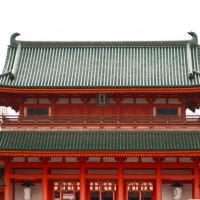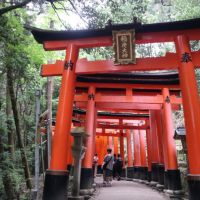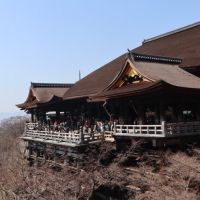Kinkakuji temple: A Golden Legacy – History and Travel Guide
S-fleage
S-fleage is a Kyoto-based company. We are proud to introduce the charms of Kyoto to the world. We hope this article will help you to experience Kyoto.
Latest posts by S-fleage (see all)
Contents
Introduction
Kinkakuji temple, also known as the Golden Pavilion, is a renowned Zen Buddhist temple located in Kyoto, Japan.
Its rich history and stunning architecture have made it one of the most iconic and visited landmarks in the country.
Kinkakuji temple, designated as a UNESCO World Heritage Site, continues to attract millions of visitors each year who come to marvel at its golden splendor and immerse themselves in the historical and spiritual ambiance.
The history of Kinkakuji temple
Kinkakuji temple, the iconic symbol of Japan’s cultural heritage, stands as a testament to the enduring beauty of its architecture and the resilience of its people in preserving their rich history.
Origins and Early History of Kinkakuji temple

Kinkakuji temple was originally built in 1397 as a retirement villa for Ashikaga Yoshimitsu, a shogun during the Muromachi period.
After Yoshimitsu’s death in 1408, the villa was converted into a Zen temple according to his will.
The Golden Pavilion gained its name due to the breathtaking exterior covered in gold leaf, which reflects beautifully on the surrounding Kyokochi Pond.
Tragedy struck in 1950 when a novice monk set fire to the temple, resulting in the complete destruction of the upper floors.
However, the temple was painstakingly reconstructed in 1955, faithful to its original design.
The restoration efforts were funded by both Japanese citizens and international donors, showcasing the global significance of this cultural treasure.
Kinkakuji temple is a prime example of the Muromachi period’s architectural style, blending Shinden, Samurai, and Zen temple design elements.
The Onset of Restoration
The reconstruction of Kinkakuji temple (Rokuon-ji) has seen several significant periods throughout its history.
During the Sengoku period and the early Edo period (16th to 17th Century), Japan experienced a turbulent era of civil wars, and this tumultuous time also affected Kinkakuji temple.
Particularly in the late Sengoku period of the Muromachi era, the temple faced the challenges of wars and fires, resulting in damage to the structure.
The current structure of Kinkakuji temple dates back to the 17th century during the mid-Edo period.
This reconstruction brought a renewed splendor to Kinkakuji temple.
And then, as mentioned earlier, Kinkakuji temple was set on fire.
The history of Kinkakuji temple, with its cycles of construction and reconstruction amid various historical challenges, highlights its enduring importance and beauty.
Cultural Heritage and Recognition
In 1994, Kinkakuji temple was designated as a UNESCO World Heritage Site, further acknowledging its historical and cultural significance.
The temple’s harmonious blend of Shinden, Samurai, and Zen architectural styles continues to attract visitors from around the globe.
How to get to Kinkakuji temple
Embarking on a journey to Kinkakuji temple is an exciting adventure filled with cultural wonders. To make your visit seamless, let’s explore the various transportation options and guide you on how to reach this iconic destination.
From Kansai international airport to Kyoto station
Navigating from Kansai International Airport to Kyoto Station offers various convenient options, allowing you to choose the mode of transportation that suits your preferences.
Airport Express Train (Haruka)
Purchase Tickets: Upon arrival at Kansai International Airport, head to the JR West Ticket Office to purchase tickets for the Haruka Airport Express Train bound for Kyoto.
Boarding the Haruka Train: Follow the signs to the Haruka train platform. The Haruka train departs directly from the airport and offers a comfortable and scenic journey to Kyoto Station.
Travel Time: The travel time on the Haruka train is approximately 75-80 minutes, providing ample time to relax and enjoy the picturesque views.
Airport Limousine Bus
Bus Terminal Location: Locate the Airport Limousine Bus Terminal at Kansai International Airport. It is on the first floor.
Purchase Tickets: Purchase your bus ticket to Kyoto Station at the terminal counter. Boarding the Bus: Board the Airport Limousine Bus bound for Kyoto Station.
Travel Time: The bus journey takes around 90-120 minutes, depending on traffic conditions.
Taxis and Rental Cars
Taxi Services: Taxis are available at the airport, providing a convenient but pricier option. Inform the driver of your destination, Kyoto Station.
Rental Cars
Rental car services are also available at Kansai International Airport if you prefer the flexibility of driving.
From Shin-Osaka station to Kyoto station
To travel from Shin-Osaka station to Kyoto station, you can take the JR (Japan Railways) Tokaido Shinkansen. The Tokaido Shinkansen is a high-speed train that connects major cities in Japan.
First, go to Shin-Osaka station and locate the Shinkansen platforms. Shin-Osaka is a major transportation hub, and you can easily find signs directing you to the Shinkansen area.
Purchase a Shinkansen ticket for the Hikari or Kodama train bound for Kyoto at the ticket counters or vending machines. Make sure to check the departure time and platform information.
Then proceed to the designated Shinkansen platform. Look for the train with the appropriate departure time and destination (Kyoto).
Enjoy the high-speed journey to Kyoto station. The travel time is relatively short (about 15-30min), and the Shinkansen provides a comfortable and efficient way to reach Kyoto.
From Kyoto station to Kinkakuji temple
Upon reaching Kyoto Station, you’ll find yourself at the heart of the city. There are several ways to get to Kinkakuji temple from here.
Bus
From Kyoto Station, head to the bus terminal.
|
Bus No. |
Terminal |
Travel time (min) |
Bus fare |
Exit station |
Bus departure |
|
101 |
B2 |
37 |
230 |
Kinkakuji temple Michi |
every 20 to 30 minutes |
|
205 |
B3 |
45 |
230 |
Kinkakuji temple Michi |
every 20 to 30 minutes |
|
Kinkakuji temple Express |
B2 |
31 |
230 |
Kinkakuji temple Michi |
2 to 3 buses per hour |
Taxi
Taxis are available at Kyoto Station and offer a convenient but pricier option. Inform the driver you are heading to Kinkakuji temple, and they will take you directly to the entrance.
The taxi fare from Kyoto Station to Kinkakuji temple varies depending on traffic conditions but generally ranges from ¥3,000 to ¥5,000. The journey takes approximately 20 to 30 minutes.
On foot
You can get maps of Kyoto designed for tourists at Kyoto Station. These maps are often available for free within the station premises or at tourist information centers.
They include information about major tourist destinations, transportation options, and local facilities, making them highly convenient for travelers.
These maps prove useful in discovering Kyoto’s captivating places and historical landmarks.
Walking from Kyoto to Kinkakuji temple has several charms:
Scenic Enjoyment: By walking, you can leisurely appreciate the beautiful landscapes and traditional buildings of Kyoto. Walking through the streets and experiencing the seasonal changes allows you to enjoy the picturesque scenery as part of your journey.
Discovery of Local Culture: Walking opens up opportunities to discover local shops, narrow alleys, and everyday scenes. It offers the chance to interact with the local culture and people.
Unexpected Discoveries: While walking, you might stumble upon small temples or traditional stores not mentioned in guidebooks. The joy of exploration comes from these unexpected discoveries.
Basic information of Kinkakuji temple
I will provide you with basic information about Kinkakuji temple.
It’s recommended to check and confirm details such as opening hours and admission fees in advance to plan your visit to Kinkakuji temple systematically.
Entrance fee
Regular Admission: The standard entrance fee for adults is 500 yen.
Children’s Admission: The admission fee for elementary and middle school students is 300 yen.
Business hours of Kinkakuji temple
The opening hours are from 9:00 AM to 5:00 PM. It opens every day,
Please note that the opening hours may vary during special viewings.
Annual events
Occasionally, Kinkakuji temple hosts special events or exhibitions.
In such cases, there may be separate admission fees.
Check the official website or local announcements for information on any ongoing events during your planned visit.
Please refer to this detailed schedule for more information.
https://www.shokoku-ji.jp/kinkakuji/event/
The highlight of Kinkakuji temple

Kinkakuji temple is widely renowned for its golden exterior, which you might have seen in photographs.
However, the highlights of Kinkakuji temple extend beyond its distinctive appearance.
I will introduce you to its captivating features, including beautiful gardens and opportunities for experiencing Japanese culture.
The Golden Exterior
Kinkakuji temple, also known as the Golden Pavilion, is renowned for its stunning golden exterior.
The temple’s top two floors are entirely covered in brilliant gold leaf, creating a captivating and resplendent sight.
The golden reflection shimmering on the surrounding pond enhances the majestic ambiance, making Kinkaku-ji one of Kyoto’s most iconic and visually striking landmarks.
The use of gold leaf not only symbolizes the opulence of the structure but also serves spiritual purposes, adding a sense of transcendence to the temple’s aesthetic allure.
The first floor features the Shinden style with its opulent interior.
The second floor incorporates samurai house elements with gold leaf covering the exterior.
The top floor is a Zen meditation hall that provides panoramic views of the surrounding gardens and landscape.
The meticulously landscaped gardens
The meticulously landscaped gardens surrounding Kinkakuji temple feature a pond with carefully arranged small and large islands.
Depending on the viewing angle, these islands create varying and captivating scenes, enhancing the overall ambiance.
Stroll through pathways adorned with vibrant flora, reflective ponds, and scenic views.
Each step unveils a new perspective of the temple and its natural surroundings.
Engage in traditional tea ceremonies at Kinkakuji temple

Within the precincts of Kinkakuji temple, there is a tea house where you can enjoy the traditional Japanese tea(Matcha).
Matcha (with a sweet): ¥500
You pay the matcha fee at the entrance before entering.
You can choose to have your matcha either at the outdoor tea seats or on the tatami mats inside.
The outdoor tea seats are surrounded by greenery and provide a pleasant atmosphere,
but since they are located next to the pathway for visitors, there is frequent foot traffic.
Many people pass by while looking at the tea seats, so if you’re concerned about being observed, you might find the tatami mat seating more serene.
Seasonal attraction of Kinkakuji temple

Kinkakuji temple, or the Golden Pavilion, is a captivating destination in Kyoto that transforms with the seasons, offering visitors a kaleidoscope of natural beauty throughout the year.
Spring (March to May): When it comes to Kyoto, cherry blossoms are often associated with its scenic beauty. However, within the precincts of Kinkakuji temple, there are only a handful of cherry blossom trees. The modest surroundings contribute to highlighting the opulence of Kinkakuji temple, creating a distinctive contrast.
Summer (June to August): The lush greenery surrounding Kinkakuji temple comes to life during the summer months. The temple’s reflective pond and meticulously maintained gardens provide a tranquil escape, offering a serene atmosphere for visitors to explore and appreciate the Zen-inspired landscapes.
Autumn (September to November): Fall paints Kinkakuji temple in warm hues of red, orange, and gold as the foliage changes. The surrounding maples transform into a vibrant spectacle, casting a fiery glow on the temple and its surroundings. Autumn is a particularly popular time to visit, as the temple harmonizes with the natural palette of the season.
Winter (December to February): In winter, Kinkakuji temple takes on a serene charm. The bare branches of surrounding trees reveal the temple’s elegant silhouette against the backdrop of a tranquil pond. Dustings of snow can enhance the temple’s golden exterior, creating a serene winter wonderland.
Regardless of the season, Kinkakuji temple’s beauty is not confined to the temple itself.
The meticulously landscaped gardens and the reflective pond enhance the overall experience, inviting visitors to immerse themselves in the ever-changing, yet timeless, allure of this cultural treasure.
Whether vibrant autumn foliage, or a blanket of snow, Kinkakuji temple continues to enchant visitors with its seasonal transformations, offering a unique and memorable experience year-round.
If you want to get much more about Kinkakuji temple, check this out↓
Some Tips for Visiting Kinkaku-ji Temple
Exploring Kinkakuji temple on foot takes about 40 minutes. There are some slopes, so please be cautious.
Kinkakuji temple is a highly popular tourist destination, so it can get very crowded during the peak season. Especially from late March to mid-April, it is filled with tourists.
During busy periods, it can be challenging to catch a bus or hail a taxi to visit Kinkakuji temple. In such cases, it is recommended to use a taxi-hailing app to personally call for a taxi.
Kinkakuji temple, the place you should visit at least once in your life.

Kinkakuji temple stands as a symbol of Japan’s rich cultural heritage, a golden beacon that beckons travelers from around the world.
Whether you’re drawn to its shimmering exterior, serene surroundings, or spiritual significance, a visit to the Golden Pavilion is an unforgettable journey through time and beauty.
Immerse yourself in the magic of Kinkakuji temple, where the past meets the present in a golden embrace.




